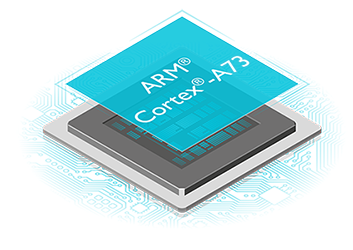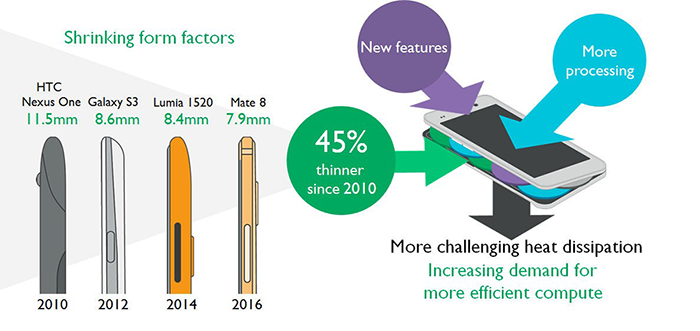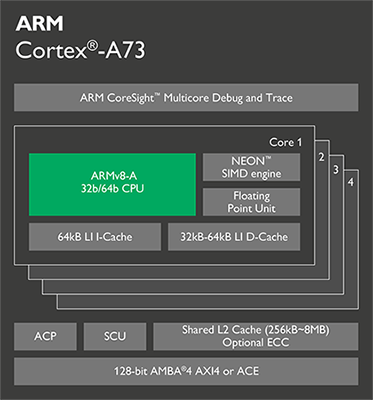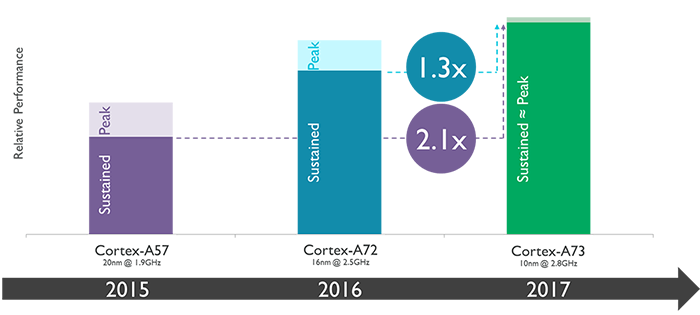The most efficient Premium CPU

This is a guest blog by Lionel Belnet, CPU Product Manager at ARM. The views expressed in this blog are his and his alone. We invited Lionel to share some of his thoughts on Cortex-A37, announced this week as a cutting-edge processor primed to appear in next-generation smartphones.
Introducing New ARM Cortex-A73 Processor: the most efficient Premium CPU, for the best mobile user experience
Today ARM announced its latest high-performance processor, the Cortex-A73. After introducing Cortex-A72 just last year, ARM is accelerating its innovation pace with the Cortex-A73 processor, which will power premium smartphones by early 2017.
The Cortex-A73 is designed and optimized specifically for mobile and consumer devices. The aspects of Cortex-A73 that I’m most excited about are all about efficient performance:
- Delivers the highest performance in the mobile power envelope, at frequencies up to 2.8GHz
- With 30% better power efficiency to sustain the best user experience
- Inside the smallest ARMv8-A footprint ever
Evolution of the Premium Smartphone
Before going into the technical details, let’s have a look at the main trends that drove our design choices for the Cortex-A73. Designing a new processor for premium smartphone is an exciting task. Smartphones are now ubiquitous; over 1.5 billion handsets will be sold this year. The performance of smartphones, nearly all of which are powered by the ARM processors, has grown by 100x since 2009. Stop for a minute and think about that – 100x performance… that enables entirely new functionality, incredibly fast user responsiveness, and amazingly immersive user experience – all in the same power footprint. Smartphones are now the portal to future innovation, such as augmented and virtual reality, ultra-HD visualization, object-based audio processing or computer vision, all of which are driving the demand for extra system performance. Meanwhile their design has become thinner over the last years, limiting the thermal dissipation. Battery capacity improvement cannot continue as smartphones have gotten as large as they practically can. To continue enhancing the user experience, we need to deliver more sustained performance with higher efficiency.
I’ve had the privilege of sitting alongside the design team that has created the Cortex-A73, with the specific intent of meeting this challenge: to be the most efficient and highest performance ARM processor. In the following sections, I’ll take you through an overview of the main features and key enhancements of the Cortex-A73 and their resulting benefits.
Cortex-A73: ARMv8-A high-performance processor
Starting with the basics, the Cortex-A73 supports the full ARMv8-A architecture. Its feature set is ideal for mobile and consumer devices. ARMv8-A includes ARM TrustZone technology, NEON, virtualization and cryptography. Both in 32-bit and 64-bit, the Cortex-A73 gives access to the widest mobile application and middleware eco-system – mobile software is developed and optimized by default on the ARM architecture.
The Cortex-A73 includes a 128-bit AMBA 4 ACE interface enabling integration in ARM big.LITTLE systems, either with the highly efficient Cortex-A53 in premium designs or with our latest ultra-efficient Cortex-A35 processor in mid-range and more cost constrained designs.
Highest performance
The Cortex-A73 processor is designed for your next-generation premium smartphone. When implemented in the advanced 10nm technology, the Cortex-A73 delivers 30% more sustained performance than our most recent previous high-performance CPU, the Cortex-A72. Running at frequencies up to 2.8GHz, the Cortex-A73 also delivers the highest peak performance, almost matched by the sustained performance of its extreme energy efficiency. What you’ll notice in the chart below is that the Cortex-A73 can sustain operation at nearly peak frequency, a rarity in mobile phone processors today, where real-world frequencies get throttled back.














